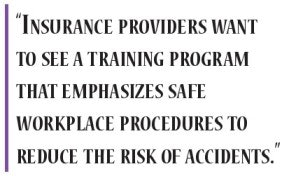Here's how to control the cost of on-the-job injuries in three easy steps

If you're like most small-business owners, you're concerned about the rising costs of employee benefits. And few such costs are rising as rapidly as the cost of workers-compensation insurance.
Workers-comp premiums have risen 50 percent nationwide in the past three years, the fastest pace in a decade. The increase has been particularly rapid in Sun Belt states such as Florida and Texas - and California, where rates have nearly doubled over the past several years, prompting some business owners to move elsewhere.
"Employers are up in arms," says Daniel C. Free, president of the Indianapolis-based risk-management consulting firm Insurance Audit and Inspection (www.insuranceaudit.com). "Some businesses are getting back-to-back increases of 25 to 40 percent, even if they have favorable workplace accident rates. No insurance buyer knows how to budget for a 20 percent increase that turns out to be twice that number. And employers often don't know what the new rates will be until a few weeks before renewal time. Then, of course, it's too late to shop around."
The big increase comes on the heels of a decades-long effort by many business owners to reduce the risks inherent in their operations. "The irony is that in many respects the workplace is safer than it has ever been," says P.J. Crowley, vice president of the New York City-based Insurance Information Institute (www.iii.org). "The root cause of the problem is the escalating cost of medical care and the number of prescribed follow-up visits to medical professionals."
Adding fuel to the fire is the length of time injured workers stay off the job, the continuing leak of wages that must be paid while they are on leave, and the cost of replacement labor.
About half the states allow you to reduce your workers-comp costs by paying a deductible or by using managed-care organizations to provide required care. But you can't reduce the level of workers comp benefits as you can with health insurance. That's because states mandate full coverage for treatment of on-the-job injuries.
But there are three steps you can take, workers-comp experts say, in your effort to control costs:
STEP #1:
INCREASE WORKPLACE SAFETY.
By far the most important step you can take is to identify and address the riskiest areas of your operation. Reducing the number of accidents in your workplace will directly affect your expenses for replacement labor, while reducing your risk of getting hit with higher insurance rates as a result of poor workplace conditions.
"Insurance providers look at your track record," says Crowley. "They want to see evidence that you are taking control of your costs by getting workers the care they need, but also getting them back on the job as quickly as they are able. They also want to see a training program that emphasizes safe workplace procedures to reduce the risk of accidents."
Small-business owners especially must be vigilant about workplace safety. "If losses accumulate to any great degree, your insurance company will cancel coverage," says Free. "And you are going to have to tell prospective replacement carriers why you got canceled. If they decide not to take on the risk you will be thrown into your state's assigned-risk pool. That's expensive."
Business owners should look for a number of ergonomic areas that commonly lead to workplace injuries, including:
• Floor coverings. Many employees in a health-club setting stand much of the day. Therefore, floor surfaces, even in non-performance areas, should be specified that reduce the resultant shock to the legs and back. Also, make sure employees wear the right shoes to reduce fatigue.
• Trip hazards. Wires leading from cardiovascular machines are the most commonly cited trip hazards in health clubs, but you might find others by looking at your facility the way an insurance adjuster might.
• The front desk. A number of computer accessories are designed to reduce the risk of carpal tunnel syndrome by reducing repetitive wrist motions. Do you have them?
• Computer screens. Adjust screen positions to avoid headaches that can turn into costly time off.
• Chairs. Does your office staff sit all day long. Install chairs that support the lower back and mandate regular stretching and walking times.
• Lifting and moving. Anyone who needs to lift and move free weights or group-exercise equipment should wear appropriate lower-back braces. Sprained backs are the most common workplace injury.
• Storage rooms. Equipment and supplies stacked the wrong way can fall over. Be vigilant when it comes to storage room design and management.
STEP #2:
GET EMPLOYEES BACK QUICKLY.
Workplace safety is great, but accidents will happen. When they do, you need to get the injured worker back as soon as feasible. Indeed, it's the staying-at-home part that is most costly for employers. The expense starts with the need to hire replacement workers. "Think of the time it takes to train someone to do an injured worker's job," says Free. "Furthermore, temp agencies charge huge fees that continue until your worker returns. None of that is covered by insurance."
The costs don't end with the temp agency bill. Untrained employees just don't have your regular staff's expertise. Furthermore, employees who stay out of the workplace longer than necessary may get too comfortable and decide to lengthen their stay indefinitely, or even to build a lawsuit against your business.
The trick, then, is to institute a program that encourages early return. "We estimate that a good back-to-work program will reduce the cost of having an injured party at home by some 40 to 50 percent," says Norman A. Peterson, President of Norman Peterson & Associates (www.returntowork.com), a consulting firm that specializes in workers-compensation issues.
Peterson's suggestion: "Create, in advance, a modified temporary position to bring any injured worker back on the day of the injury." At first blush, it seems counterintuitive that an injured worker could get back to work right away. However, you can easily develop productive positions for which the worker's injury does not rule out participation.
"Someone who works the workout floor might not be able to resume full duties right away," says Crowley. "However, that same worker might be able to return to work and be given some responsibilities that are not as physically taxing."
STEP #3:
COMMUNICATE YOUR CONCERN.
If you don't express your concern about rising costs, how will people know? Reach out to everyone involved in the health-care network. Take these steps:
• Communicate the problem with your workforce. You know that workers-comp costs are escalating, but do your employees? Chances are they have no idea how much you have to pay for workers comp or how it affects the health of the company that provides their paychecks. Sharing this information will open their eyes to the problem and might spur them to help - by fostering workplace safety, and by returning to work quickly if they are injured.
• Communicate with medical professionals. Workers aren't the only ones who need education about the cost of workers comp: So do doctors. "Doctors tend to prescribe the maximum medical care available," says Crowley. "Make sure the medical providers who treat your workers are familiar with the workers comp system and prescribe what your workers need but not more than they need."
A big part of the education solution is to make sure the doctor knows the demands of the position held by the injured worker and the alternative position that you have made available for the employee.
• Express concern for the injured worker. Remember that the injured worker is stewing at home, irritated that he or she has been hurt and perhaps angry at your business. Such negative feelings can escalate if the worker feels you do not care what has happened. "Employers who are viewed as uncaring open themselves up to claims that are not legitimate," says Free. "There is a lot of workers-comp fraud out there."
As with most areas of business, it pays to be proactive. Ask your insurance company to visit your place of business and conduct a job-safety analysis.
Get to know the relevant federal and state laws by visiting www.law.cornell.edu, a site hosted by the Legal Information Institute at Cornell Law School. (Click on "Law About," then "Accident and Injury Compensation," and then "Workers Compensation.") Most of all, keep records of everything you do related to the health of your workers.
"In this tight insurance market, carriers will want to see documentation that you are controlling costs and reducing risks," says Crowley. "So when you take proactive steps, you enjoy the prospect of insurance savings."



































